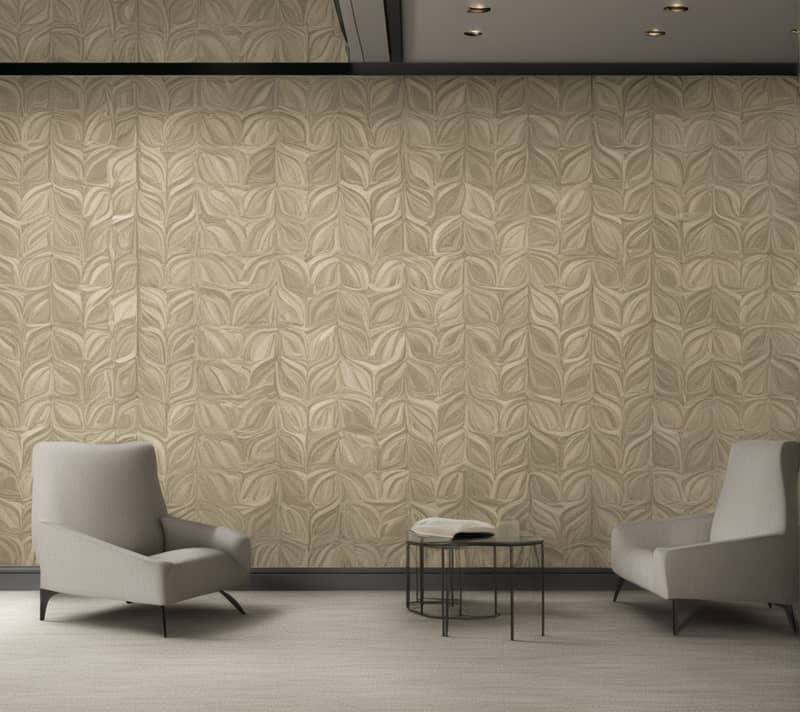In the fast-paced world of commercial interior design, businesses are increasingly focusing on sustainability, and one essential element of this movement is sustainable commercial wallcoverings. We’ll explore the concept of sustainable wallcoverings, their advantages, types, installation, and the environmental impact. Let’s dive in.
What Are Sustainable Commercial Wallcoverings?
Sustainable commercial wallcoverings are eco-friendly interior design materials used in various commercial spaces, including offices, hotels, restaurants, and retail stores. These wallcoverings are designed with a focus on reducing their environmental impact throughout their life cycle. They are a testament to the growing commitment of businesses to reduce their carbon footprint.
Benefits of Sustainable Commercial Wallcoverings
Eco-Friendly Materials
Sustainable wallcoverings are often made from recycled or renewable materials. They minimize the extraction of virgin resources and help in conserving nature. These materials are sourced responsibly, ensuring that the environment is not harmed in the process.
Energy Efficiency
Incorporating sustainable wallcoverings can lead to improved energy efficiency. They often come with insulating properties that help maintain a comfortable indoor temperature, reducing the need for excessive heating or cooling.
Durability
Sustainable commercial wallcoverings are built to last. They are known for their durability, meaning they won’t need frequent replacements. This extends the life of the wallcoverings and reduces waste.
Aesthetic Appeal
Who said sustainability can’t be stylish? Sustainable wallcoverings come in various designs and textures, ensuring that businesses don’t have to compromise on aesthetics.
Types of Sustainable Wallcoverings
Recycled Materials
Some sustainable wallcoverings are made from post-consumer or post-industrial recycled materials. These materials would otherwise end up in landfills, making the wallcoverings a greener choice.
Biodegradable Options
Biodegradable wallcoverings are designed to naturally break down at the end of their life cycle, reducing the burden on landfills.
Low VOC Wallcoverings
Low VOC (Volatile Organic Compounds) wallcoverings emit fewer harmful chemicals, improving indoor air quality.
Installation and Maintenance
Professional Installation
For the best results and longevity, it’s recommended to have sustainable wallcoverings installed by professionals.
Maintenance Tips
Proper care and cleaning can extend the life of these wallcoverings. Regular dusting and cleaning with eco-friendly products are advisable.
Sustainable Wallcoverings in Interior Design
Enhancing Aesthetics
Sustainable wallcoverings can enhance the overall aesthetics of a commercial space, contributing to a pleasant ambiance.
Creating a Positive Brand Image
Choosing sustainability in design can send a powerful message about a business’s commitment to environmental responsibility, positively impacting its brand image.
Elevating Employee Productivity
A green workspace with sustainable wallcoverings can boost employee morale and productivity.
Cost Considerations
Upfront Costs vs. Long-term Savings
While sustainable wallcoverings may have a higher initial cost, the long-term savings in reduced maintenance and replacement costs make them a sound investment.
Challenges of Sustainable Wallcoverings
Limited Design Choices
Compared to traditional options, sustainable wallcoverings may have a more limited range of designs and textures.
Cost Barriers
The initial cost can be a deterrent for some businesses, especially small ones. However, it’s essential to consider the long-term benefits.
Case Studies: Sustainable Wallcovering Success Stories
Case 1: Eco-Friendly Hotel Redesign
In this case, a renowned hotel chain embraced sustainable wallcoverings during a redesign, significantly reducing its environmental impact while maintaining a luxurious ambiance.
Case 2: Sustainable Office Renovation
An office space used sustainable wallcoverings in its renovation, creating an eco-friendly and productive work environment.
Sustainable Wallcoverings and the Environment
Reducing Environmental Impact
Sustainable wallcoverings play a vital role in reducing the environmental impact of interior design, helping to combat climate change.
Recycling and Disposal
Many sustainable wallcoverings are designed for easy recycling or repurposing, reducing waste.
Market Trends and Future Outlook
Growing Demand for Sustainability
The demand for sustainable wallcoverings is on the rise as more businesses commit to green practices.
Innovations in Sustainable Wallcoverings
Ongoing research and innovation are expanding the options for sustainable wallcoverings, providing more choices to businesses.
Conclusion
Sustainable commercial wallcoverings are not just a trend; they are a commitment to a greener future. By choosing these eco-friendly materials, businesses can enhance their spaces, reduce their environmental footprint, and send a powerful message about their commitment to sustainability. In a world that values responsible design, sustainable wallcoverings are a clear choice.
FAQs
FAQ 1: Are sustainable wallcoverings more expensive than traditional options?
While sustainable wallcoverings may have a higher upfront cost, they often lead to long-term savings due to their durability and low maintenance requirements.
FAQ 2: How can I identify truly sustainable wallcoverings?
Look for certifications such as FSC (Forest Stewardship Council) or Greenguard to ensure the sustainability of wallcoverings.











